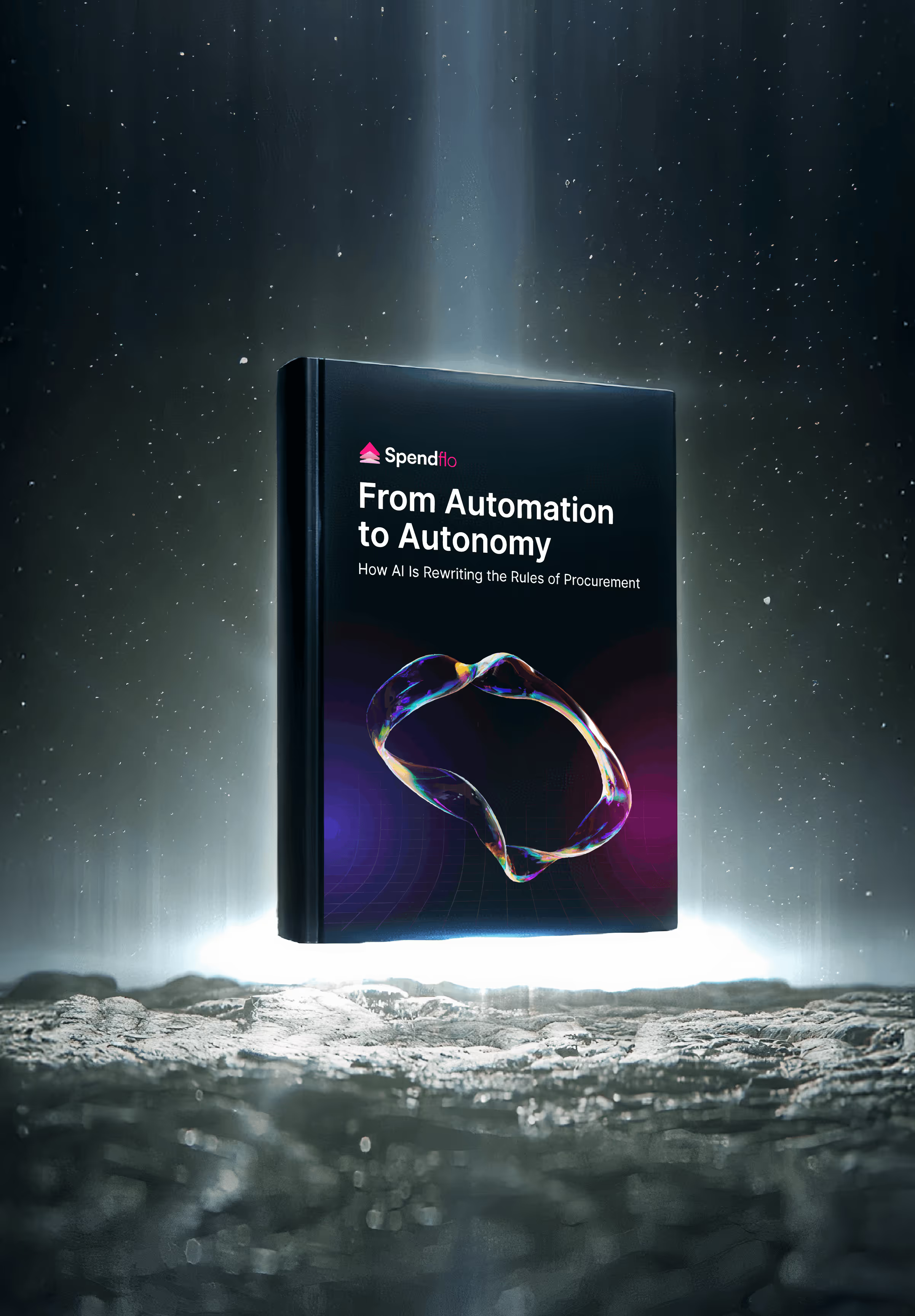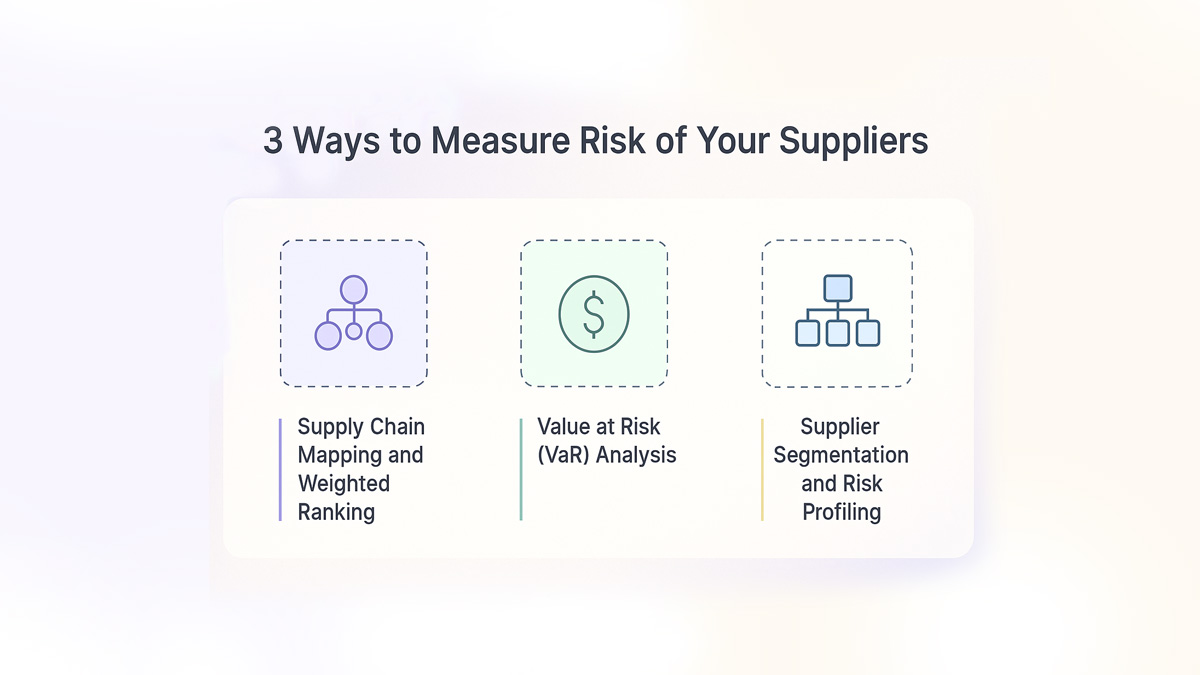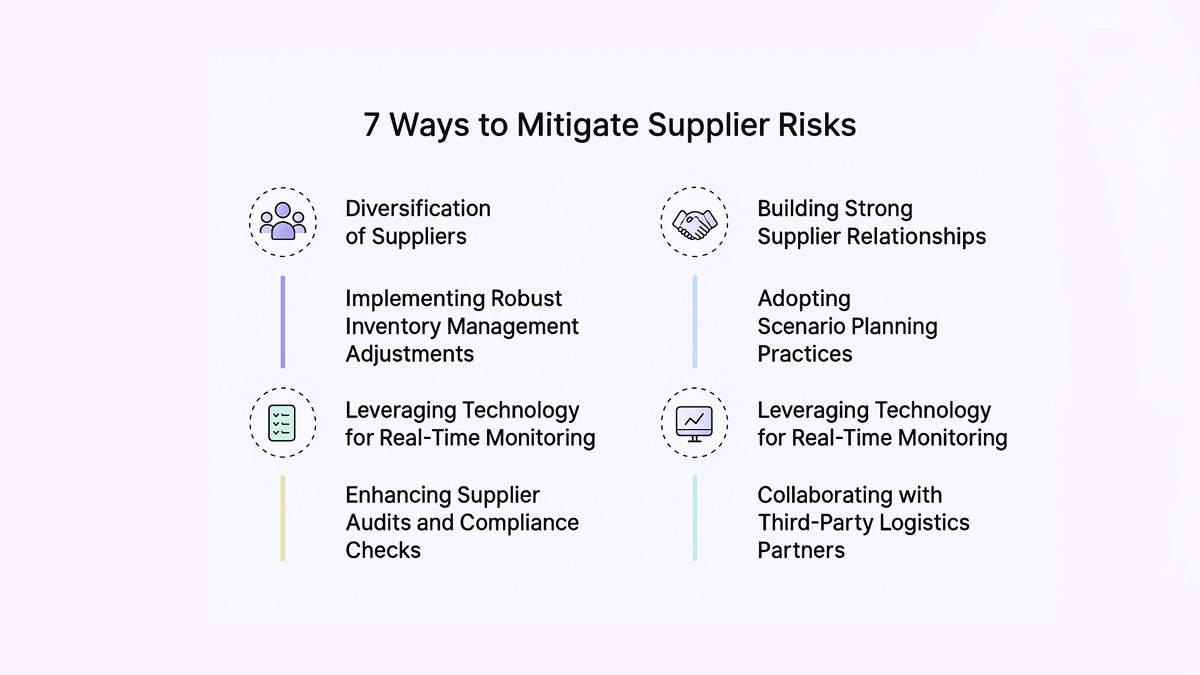

10 Supply Chain Risks and How to Mitigate Them

10 Supply Chain Risks and How to Mitigate Them
Explore 10 major supply chain risks and mitigation strategies to protect operations, reduce disruptions, and strengthen resilience.


In today’s interconnected business environment, supply chain risks have become a critical concern for companies of all sizes. From raw material shortages to unexpected geopolitical conflicts, disruptions can occur at any stage of the chain, affecting costs, timelines, and customer satisfaction. For organizations aiming to stay competitive, identifying and mitigating these risks is no longer optional - it’s a business imperative.
This blog covers:
- What are supply chain risks
- Why supply chain risks are increasing
- 10 most common supply chain risks
- 3 strategies to assess supplier risk
- 7 strategies to mitigate supplier risks
- Which supply chain technology is essential for risk management
- How Spendflo helps with supplier risk management
- Frequently asked questions on supply chain risk
What Are Supply Chain Risks?
Supply chain risks are events or conditions that disrupt the flow of goods, services, or information. They can be internal, like inefficiencies, or external, like natural disasters or political instability, affecting costs, timelines, and overall business performance.
Why Supply Chain Risks Are Increasing?
Global supply chains are more complex and interconnected than ever, and with that complexity comes heightened vulnerability.
Here are the key factors that are driving the rise in supply chain risks:
Globalization of Operations
While sourcing and selling globally offers cost and market advantages, it also exposes companies to disruptions caused by geopolitical tensions, trade disputes, and varying regulations across regions.
Climate Change and Natural Disasters
Unpredictable weather events, such as floods, hurricanes, and wildfires, are increasing in frequency and severity, impacting production sites and logistics networks.
Technological Vulnerabilities
As more supply chain processes move online, cyberattacks and system failures present significant threats to operational continuity.
Labor and Skills Shortages
Ongoing labor shortages in logistics, manufacturing, and transportation sectors contribute to delays, higher costs, and reduced capacity.
Economic Volatility
Fluctuating currencies, inflationary pressures, and sudden supplier bankruptcies can destabilize entire supply networks, especially for small and midsize businesses that depend heavily on a few key suppliers.
These growing challenges mean companies must strengthen their risk assessment processes and develop strategies that make their supply chains more agile and resilient.
10 Supply Chain Risks
Supply chain risks come in many forms, each capable of disrupting operations, increasing costs, and damaging customer trust.
Here are the most common threats businesses face today:
1. Disruptions from Natural Disasters
Earthquakes, floods, hurricanes, and wildfires can halt production, damage infrastructure, and delay deliveries for weeks or months.
Impact:
- Immediate suspension of manufacturing and logistics operations.
- Long-term damage to supplier facilities and infrastructure.
- Increased costs for rerouting, insurance, and recovery.
- Delays in meeting customer demand, leading to lost revenue.
2. Geopolitical Tensions and Political Instability
Trade wars, sanctions, and regional conflicts can restrict access to markets, materials, and suppliers.
Impact:
- Sudden tariff increases or trade restrictions that raise procurement costs.
- Delays or cancellations in shipments due to border closures or sanctions.
- Supplier instability in politically volatile regions.
- Loss of market access, forcing companies to find alternative suppliers.
3. Economic Factors and Supplier Bankruptcies
Economic downturns, inflation, and sudden supplier insolvencies can cause unexpected supply gaps and higher procurement costs. These situations also introduce financial risks that can strain budgets and impact long-term operational planning.
Impact:
- Increased purchasing costs due to inflation and currency fluctuations.
- Higher risk of contract breaches or supplier default.
- Reduced cash flow for small and midsize businesses (SMBs).
- Disrupted long-term projects if critical suppliers go bankrupt.
4. Labor Shortages and Workforce Strikes
Shortages of skilled workers or industrial strikes in manufacturing, ports, or logistics can slow down or halt operations entirely.
Impact:
- Reduced productivity and slower turnaround times.
- Higher labor costs as companies compete for scarce talent.
- Increased reliance on third-party logistics partners to fill gaps.
- Potential shutdown of operations during prolonged strikes.
5. Inventory Shortages and Delays
Poor demand forecasting, procurement inefficiencies, or supplier delays can lead to stockouts and lost sales.
Impact:
- Inability to meet customer demand, harming brand loyalty.
- Increased costs for expedited shipping or emergency sourcing.
- Overstocking risks when forecasts overestimate demand.
6. Environmental Concerns and Sustainability Risks
Non-compliance with environmental regulations, exposure to environmental risks, or unsustainable practices can lead to fines, reputational damage, and supply chain restructuring.
Impact:
- Regulatory penalties and higher compliance costs.
- Loss of contracts with eco-conscious clients.
- Reputational damage among stakeholders and customers.
- Long-term costs of transitioning to sustainable sourcing.
7. Cybersecurity Vulnerabilities in the Supply Chain
Hacks, ransomware, and other cybersecurity risks - such as data breaches targeting suppliers or logistics providers can compromise sensitive data and halt operations.
Impact:
- Loss of sensitive supplier, customer, or financial data.
- Severe reputational damage and loss of trust.
- Costly recovery efforts, including legal liabilities.
- Operational shutdowns due to compromised systems.
8. Quality Control Failures from Key Suppliers
Defective materials or inconsistent quality standards can lead to recalls, production delays, reputational risk, and brand damage.
Impact:
- Expensive recalls that hurt profit margins.
- Production slowdowns due to rework or replacements.
- Long-term reputational risk from poor product quality.
- Strained customer relationships and reduced loyalty.
9. Logistics and Transportation Challenges
Port congestion, rising freight costs, and shipping delays can impact delivery times and profitability.
Impact:
- Delayed order fulfillment, leading to unhappy customers.
- Increased freight and fuel costs reducing margins.
- Missed deadlines for seasonal or time-sensitive products.
- Reduced reliability of third-party logistics partners.
10. Dependency on Single or Limited Suppliers
Relying heavily on one supplier increases risk exposure if they face disruptions or pricing changes.
Impact:
- Complete stoppage of production if the supplier fails.
- Reduced bargaining power, leading to higher costs.
- Limited flexibility to adapt to sudden demand risks.
3 Strategies to Assess the Risk of Your Suppliers
Before you can mitigate supply chain risks, you need a clear picture of where they originate. These proven strategies help evaluate and prioritize supplier risks effectively:

1. Supply Chain Mapping and Weighted Ranking
Visualize every tier of your supply chain - from raw material sources to distribution partners. Assign a weighted ranking based on factors like supplier location, lead times, and operational stability. This helps identify high-risk nodes that could cause the most disruption.
2. Value at Risk (VaR) Analysis
Calculate the potential financial loss if a supplier fails to deliver. VaR analysis quantifies the monetary impact of disruptions, helping you prioritize which suppliers require contingency planning or diversification. Incorporating detailed risk profiles into this analysis offers a clearer view of both financial exposure and operational vulnerabilities. This is especially valuable for high-value contracts or mission-critical goods.
3. Supplier Segmentation and Risk Profiling
Categorize suppliers based on their importance to your business and the risks they pose. Regular supplier evaluation should be part of this process, ensuring ongoing compliance, performance, and alignment with company standards. Profiles may include operational reliability, compliance history, financial health, and exposure to geopolitical or environmental threats. Segmentation allows for tailored risk management strategies rather than a one-size-fits-all approach.
By combining these methods, businesses can develop a clear, data-driven understanding of supplier vulnerabilities - laying the groundwork for stronger risk mitigation plans.
7 Strategies to Mitigate Supplier Risks
Once supplier vulnerabilities are identified, the next step is to put proactive measures in place. These strategies help strengthen resilience and reduce the impact of disruptions. Regularly reviewing sourcing strategies allows companies to adjust supplier mix in response to market shifts or emerging risks.

1. Diversification of Suppliers
Avoid over-reliance on a single vendor by sourcing from multiple suppliers across different regions to reduce the impact of supply disruptions. This ensures you have backup options if one supplier faces production delays, political instability, or financial trouble.
2. Implementing Robust Inventory Management Adjustments
Use inventory buffers, safety stock, and just-in-case strategies to absorb short-term disruptions. Align inventory policies with demand forecasts to prevent both shortages and costly overstocking.
3. Building Strong Supplier Relationships
Regular communication, transparency, and collaboration foster trust. Strong relationships often mean suppliers will prioritize your orders during high-demand or shortage periods.
4. Adopting Scenario Planning Practices
Simulate potential disruption scenarios - such as port closures or raw material shortages - and develop contingency plans. Scenario planning prepares teams to act quickly and confidently during real-world crises. Integrating these scenarios into a formal business continuity plan ensures a structured, company-wide response to disruptions.
5. Leveraging Technology for Real-Time Monitoring
Supply chain management platforms and IoT sensors can track shipments, supplier performance, and inventory levels in real time. Many modern platforms now incorporate artificial intelligence to predict delays, assess risks, and recommend optimized sourcing strategies. This visibility allows you to spot problems early and take corrective action before delays escalate.
6. Enhancing Supplier Audits and Compliance Checks
Regularly audit supplier operations for compliance with quality, environmental, and labor standards. Identifying issues early reduces the risk of regulatory penalties, reputational harm, or product recalls.
7. Collaborating with Third-Party Logistics Partners
Partner with reliable 3PL providers who can offer flexible routing, warehousing, and distribution solutions during disruptions. Their expertise can help keep goods moving when traditional channels are blocked.
Implementing these strategies creates a multi-layered defense against supplier risks. By diversifying sourcing, strengthening operational visibility, and building contingency capabilities, businesses can ensure their supply chains remain stable, even in volatile conditions.
If you want deeper visibility into supplier-level vulnerabilities, explore this overview of leading Supplier Risk Management Software.
Which Supply Chain Technology Do You Need?
Managing supply chain risks effectively requires the right digital technology stack. Start with a supply chain management (SCM) platform that provides end-to-end visibility into orders, inventory, and supplier performance. Look for features such as real-time tracking, predictive analytics, and automated alerts for potential disruptions. Digital dashboards give procurement and operations teams a unified, visual view of supplier performance, shipment progress, and potential bottlenecks. Risk assessment tools that integrate with financial and compliance data help evaluate supplier stability. Advanced supply chain analytics reveal hidden inefficiencies, forecast demand changes, and guide data-driven improvements in procurement and logistics.
Additionally, inventory optimization systems and transportation management software can enhance agility during disruptions. Choosing solutions that integrate seamlessly across departments ensures faster decision-making and better control over risk.
How Spendflo Helps with Supplier Risk Management
At Spendflo, we help businesses gain complete visibility over their supplier network and procurement processes. Our platform centralizes contract and spend data, making it easier to track supplier performance and identify vulnerabilities. With automated renewal tracking, vendor benchmarking, and expert-led negotiations, we help companies diversify suppliers, reduce costs, and secure favorable terms.
By integrating risk assessment into procurement workflows, Spendflo empowers businesses to mitigate supply chain disruptions before they escalate - ensuring resilience, cost savings, and operational stability. For enterprises with complex vendor networks, vendor risk management platforms can add deeper compliance tracking and benchmarking capabilities alongside Spendflo’s core features.
Frequently Asked Questions on Supply Chain Risk
What are the main causes of supply chain risk?
Risks arise from natural disasters, geopolitical instability, economic issues, labor shortages, quality failures, and cyberattacks. These factors can delay production, increase costs, and reduce supplier reliability, affecting the entire supply chain’s performance.
How can small and midsize businesses manage supply chain risks?
SMBs can mitigate risks by diversifying suppliers, maintaining safety stock, using affordable monitoring tools, and building strong supplier relationships. These actions help ensure supply continuity and reduce dependency on a single vendor.
What role does technology play in mitigating supply chain risks?
Technology enables real-time tracking, predictive analytics, and automated alerts, helping businesses detect and respond to disruptions early. Integrated systems improve visibility, streamline communication, and support faster, data-driven decision-making in risk management.
How do geopolitical issues impact supply chains?
Trade disputes, sanctions, and political unrest can disrupt material flow, increase tariffs, and delay shipments. Companies can limit exposure by sourcing from multiple regions, maintaining contingency routes, and collaborating closely with logistics partners.
What is the best first step to reduce supplier-related risks?
Start with a supplier risk assessment to evaluate financial health, reliability, and compliance. Prioritize high-risk suppliers for diversification, stronger contracts, or contingency planning to quickly strengthen overall supply chain resilience.










.png)




.png)










.avif)





